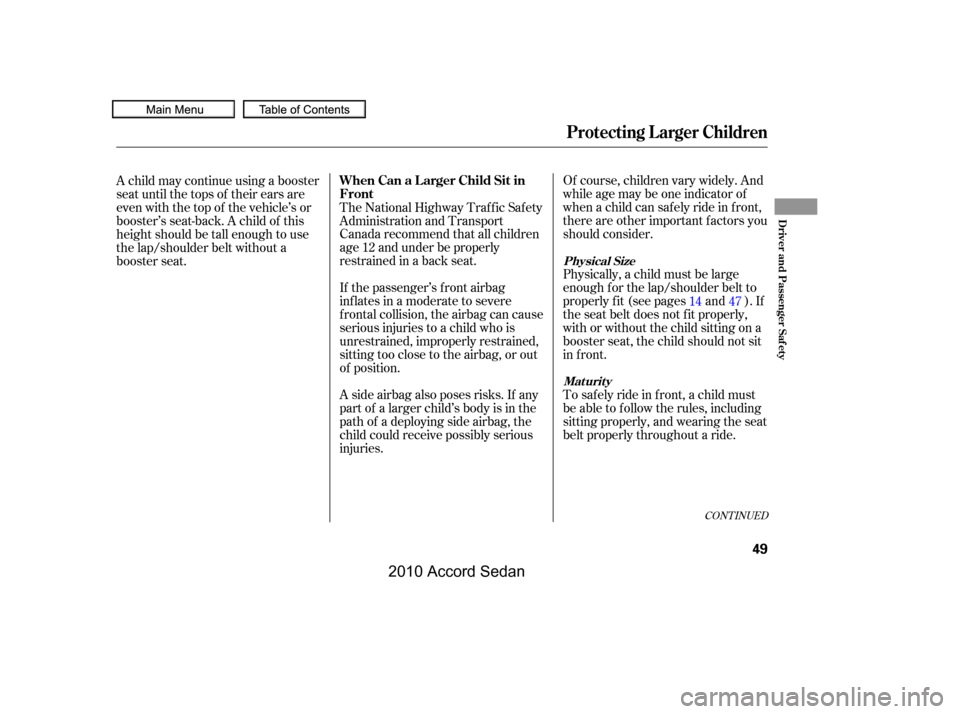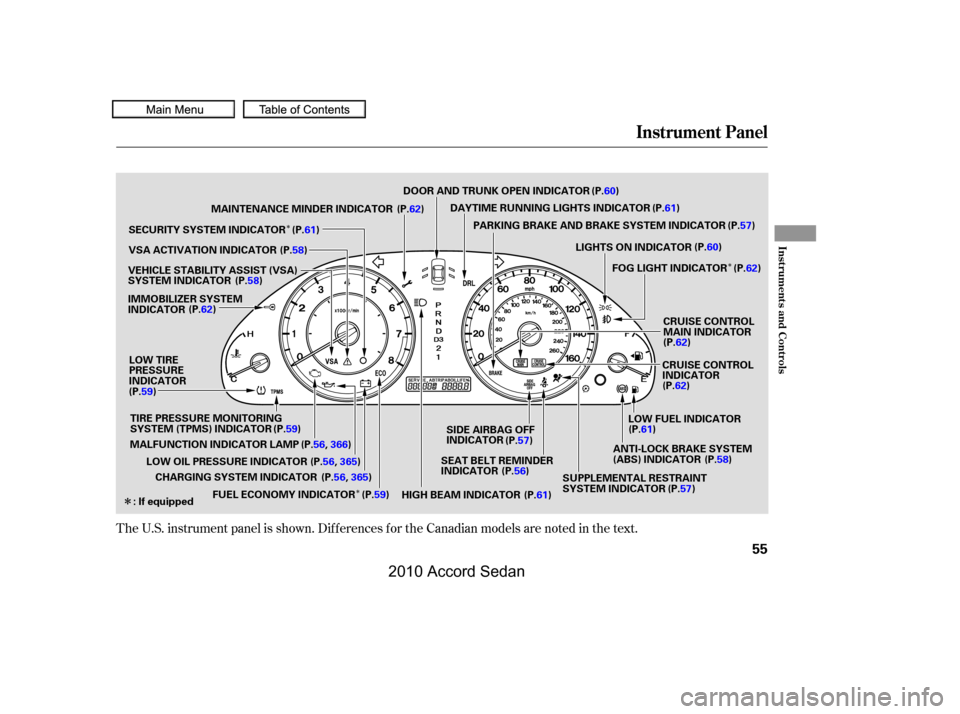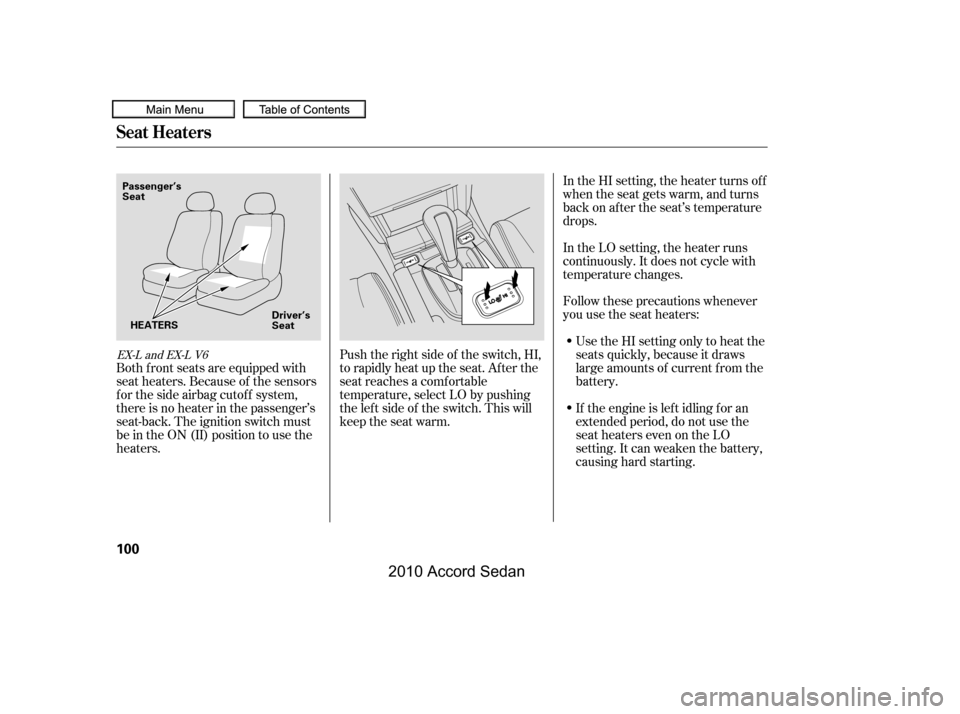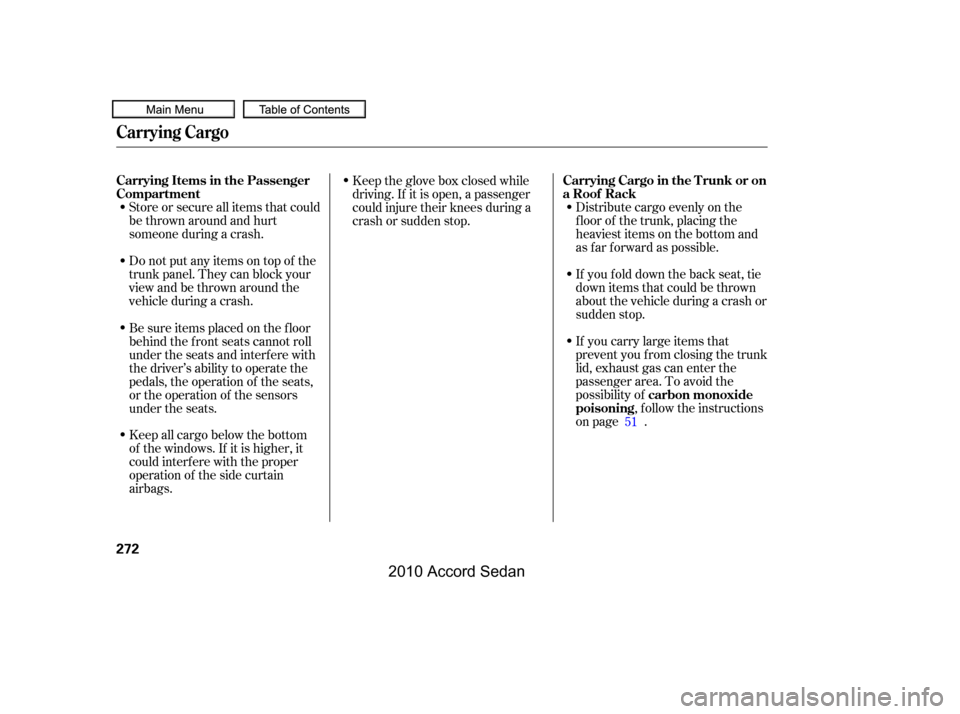Page 52 of 414

CONT INUED
Of course, children vary widely. And
while age may be one indicator of
when a child can saf ely ride in f ront,
there are other important f actors you
should consider.
Physically, a child must be large
enough f or the lap/shoulder belt to
properly f it (see pages and ). If
the seat belt does not f it properly,
with or without the child sitting on a
booster seat, the child should not sit
in f ront.
To saf ely ride in f ront, a child must
be able to f ollow the rules, including
sitting properly, and wearing the seat
belt properly throughout a ride.
The National Highway Traffic Safety
Administration and Transport
Canada recommend that all children
age 12 and under be properly
restrained in a back seat.
If the passenger’s front airbag
inf lates in a moderate to severe
f rontal collision, the airbag can cause
serious injuries to a child who is
unrestrained, improperly restrained,
sitting too close to the airbag, or out
of position.
A side airbag also poses risks. If any
part of a larger child’s body is in the
path of a deploying side airbag, the
child could receive possibly serious
injuries.
A child may continue using a booster
seat until the tops of their ears are
even with the top of the vehicle’s or
booster’s seat-back. A child of this
height should be tall enough to use
the lap/shoulder belt without a
booster seat.
14 47
Protecting L arger Children
Physical Size
Maturity
When Can a L arger Child Sit in
Front
Driver and Passenger Saf ety
49
�����—�����—�
���y�
����
����
���y���
�)�����������y���������y
2010 Accord Sedan
Page 58 of 414

�Î
�Î
�Î
�Î
The U.S. instrument panel is shown. Dif f erences f or the Canadian models are noted in the text.
Instrument Panel
Inst rument s and Cont rols
55
(P.57)
(P.62)
: If equipped
LOW FUEL INDICATOR
ANTI-LOCK BRAKE SYSTEM (ABS) INDICATOR
HIGH BEAM INDICATOR
DAYTIME RUNNING LIGHTS INDICATOR
SEAT BELT REMINDERINDICATOR
LIGHTS ON INDICATOR
CRUISE CONTROLINDICATOR
SUPPLEMENTAL RESTRAINTSYSTEM INDICATOR
SIDE AIRBAG OFFINDICATOR
IMMOBILIZER SYSTEMINDICATOR
MALFUNCTION INDICATOR LAMP
LOW OIL PRESSURE INDICATOR
(P.62)
(P.62)
(P.61)
(P.61)
(P.61)
SECURITY SYSTEM INDICATOR
(P.57)
(P.57)
(P.58)
(P.62)
PARKING BRAKE AND BRAKE SYSTEM INDICATOR
CRUISE CONTROLMAIN INDICATOR (P.62)
MAINTENANCE MINDER INDICATOR
CHARGING SYSTEM INDICATOR
(P.61)
(P.56)
(P.60)
FOG LIGHT INDICATOR
VSA ACTIVATION INDICATOR
VEHICLE STABILITY ASSIST (VSA) SYSTEM INDICATOR(P.58)
(P.58)
(P.59)FUEL ECONOMY INDICATOR
LOW TIREPRESSUREINDICATOR(P.59)
TIRE PRESSURE MONITORINGSYSTEM (TPMS) INDICATOR(P.59)
DOOR AND TRUNK OPEN INDICATOR (P.60)
(P.56,366)
(P.56,365)
(P.56,365)
�����—�����—�
���y�
����
��������y���
�)�����������y���������y
2010 Accord Sedan
Page 60 of 414

This indicator comes on brief ly when
you turn the ignition switch to the
ON (II) position. If it comes on at
any other time, it indicates a
potential problem with your f ront
airbags. This indicator will also alert
you to a potential problem with your
side airbags, passenger’s side airbag
cutof f system, side curtain airbags,
automatic seat belt tensioners,
driver’s seat position sensor, or the
f ront passenger’s weight sensors.
For more inf ormation, see page .
This indicator has two f unctions:
Itcomesonwhenyouturnthe
ignition switch to the ON (II)
position. It is a reminder to check
the parking brake. A beeper
sounds if you drive with the
parking brake not f ully released.
Driving with the parking brake not
fully released can damage the
brakes and tires.
If it remains lit af ter you f ully
release the parking brake while
the engine is running, or if it
comes on while driving, there
could be a problem with the brake
system. For more inf ormation, see
page .
This indicator comes on brief ly when
you turn the ignition switch to the
ON (II) position. If it comes on at
any other time, it indicates that the
passenger’s side airbag has
automatically shut off. For more
inf ormation, see page .
1.
2.
29
367
30
Supplemental Restraint
System Indicator
Parking Brake and Brake System
Indicator
Side Airbag Of f Indicator
Instrument Panel Indicators
Inst rument s and Cont rols
57
U.S. Canada
CanadaU.S.
�����—�����—�
���y�
����
��������y���
�)�����������y���������y
2010 Accord Sedan
Page 70 of 414
�Î
�Î
�Î�Î
�Î
�Î
�Î
�Î
�Î
�Î
If equipped
Only on vehicles equipped with navigation system, ref er to the navigation system manual.
To use the horn, press the center pad of the steering wheel.1:
2:
3:
Controls Near the Steering Wheel
Inst rument s and Cont rols
67
INSTRUMENT PANEL BRIGHTNESS
REMOTE AUDIO CONTROLS
(P.100)
(P.69,72)
(P.75)
(P.72)PASSENGER AIRBAG OFFINDICATOR(P.30)
HEADLIGHT/TURN SIGNALS/FOG LIGHTS
WINDSHIELD WIPERS/WASHERS
SEAT HEATER SWITCHES
NAVIGATION SYSTEM VOICECONTROL BUTTONS
(P.68)
(P.211)
(P.223)
(P.230)
(P.74,102)
REAR WINDOW DEFOGGER/HEATED MIRROR BUTTON
HAZARD WARNINGBUTTON(P.73)
INTERFACE DIAL (P.174)
(P.290)
STEERING WHEELADJUSTMENTS
CRUISE CONTROLBUTTONS
HORN
BLUETOOTHHANDSFREELINK VOICECONTROL BUTTONS
VEHICLE STABILITY ASSIST(VSA) SYSTEM OFF SWITCH
2
2
32
3
1
2
�����—�����—�
���y�
����
��������y���
�)�����������y���������y
2010 Accord Sedan
Page 103 of 414

Both f ront seats are equipped with
seat heaters. Because of the sensors
f or the side airbag cutof f system,
there is no heater in the passenger’s
seat-back. The ignition switch must
be in the ON (II) position to use the
heaters.
Push the right side of the switch, HI,
to rapidly heat up the seat. Af ter the
seat reaches a comfortable
temperature, select LO by pushing
the lef t side of the switch. This will
keep the seat warm.
If the engine is lef t idling f or an
extended period, do not use the
seat heaters even on the LO
setting. It can weaken the battery,
causing hard starting.
Use the HI setting only to heat the
seats quickly, because it draws
large amounts of current f rom the
battery.
Follow these precautions whenever
you use the seat heaters:
In the LO setting, the heater runs
continuously. It does not cycle with
temperature changes.
In the HI setting, the heater turns off
when the seat gets warm, and turns
back on after the seat’s temperature
drops.
EX-L and EX-L V6
Seat Heaters
100
Driver’s Seat
Passenger’sSeat
HEATERS
�����—�����—�
���y�
�������������y���
�)�����������y���
�����y
2010 Accord Sedan
Page 270 of 414

Bef ore installing any accessory:
Make sure the accessory does not
obscure any lights, or interf ere
with proper vehicle operation or
perf ormance.
Modif ying your vehicle, or installing
some non-Honda accessories, can
make your vehicle unsaf e. Bef ore
you make any modif ications or add
anyaccessories,besuretoreadthe
f ollowing inf ormation.
Your dealer has Honda accessories
that allow you to personalize your
vehicle. These accessories have
been designed and approved f or your
vehicle, and are covered by warranty.
Although non-Honda accessories
may f it on your vehicle, they may not
meet f actory specif ications, and
could adversely af f ect your vehicle’s
handling and stability.
When properly installed, cellular
phones, alarms, two-way radios, and
low-powered audio systems should
not interf ere with your vehicle’s
computer controlled systems, such
as your airbags, anti-lock brakes, and
tire pressure monitoring system.
Be sure electronic accessories do
not overload electrical circuits
(see page ) or interf ere with
the proper operation of your
vehicle.
Bef ore installing any electronic
accessory, have the installer
contact your dealer for assistance.
If possible, have your dealer
inspect the f inal installation.
Do not install accessories on the
side pillars or across the rear
windows. Accessories installed in
theseareasmayinterferewith
proper operation of the side
curtain airbags.
368
A ccessories
A ccessories and Modif ications
Bef ore Driving
267
Improper accessories or
modifications can affect your
vehicle’s handling, stability, and
performance, and cause a
crash in which you can be hurt
or killed.
Follow all instructions in this
owner’s manual regarding
accessories and modifications.
09/07/08 21:40:27 31TA5620_272
2010 Accord Sedan
Page 271 of 414

Herearesomeexamples:
Lowering the vehicle with a non-
Honda suspension kit that
signif icantly reduces ground
clearance can allow the
undercarriage to hit speed bumps
or other raised objects, which
could cause the airbags to deploy.
Raising your vehicle with a
non-Honda suspension kit can
af f ect the handling and stability.
If you plan to modif y your vehicle,
consult your dealer.
Modif ying your steering wheel or
any other part of your vehicle’s
safety features can make the
systems inef f ective.
Larger or smaller wheels and tires
can interf ere with the operation of
your vehicle’s anti-lock brakes and
other systems.
Non-Honda wheels, because they
are a universal design, can cause
excessive stress on suspension
components, and are not
compatible with the tire pressure
monitoring system (TPMS).
Removing parts f rom your vehicle,
or replacing components, with
non-Honda components could
seriously af f ect your vehicle’s
handling, stability, and reliability.
Modif ying Your Vehicle
A ccessories and Modif ications
268
�����—�����—�
���y�
�������������y���
�)�����������y���������y
2010 Accord Sedan
Page 275 of 414

Store or secure all items that could
be thrown around and hurt
someone during a crash.
Do not put any items on top of the
trunk panel. They can block your
view and be thrown around the
vehicle during a crash.
Distribute cargo evenly on the
f loor of the trunk, placing the
heaviest items on the bottom and
as far forward as possible.
If youfolddownthebackseat,tie
down items that could be thrown
about the vehicle during a crash or
sudden stop.
If you carry large items that
prevent you f rom closing the trunk
lid, exhaust gas can enter the
passenger area. To avoid the
possibility of
, f ollow the instructions
on page .
Keep the glove box closed while
driving. If it is open, a passenger
could injure their knees during a
crash or sudden stop.
Be sure items placed on the f loor
behind the f ront seats cannot roll
under the seats and interf ere with
the driver’s ability to operate the
pedals, the operation of the seats,
or the operation of the sensors
under the seats.
Keep all cargo below the bottom
of the windows. If it is higher, it
could interf ere with the proper
operation of the side curtain
airbags.
51
Carrying Cargo
Carrying Items in the Passenger
Compartment
Carrying Cargo in the Trunk or on
a Roof Rack
carbon monoxide
poisoning
272
�����—�����—�
���y�
�������������y���
�)�����������y���������y
2010 Accord Sedan